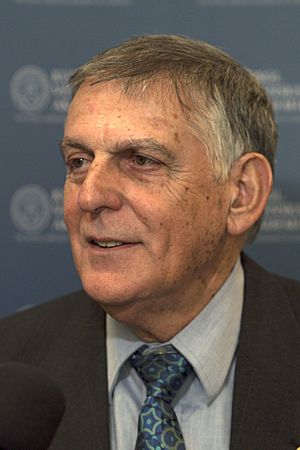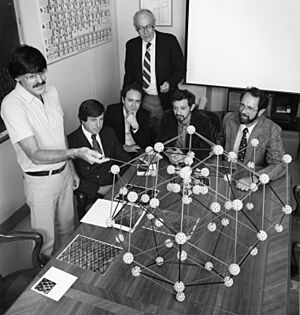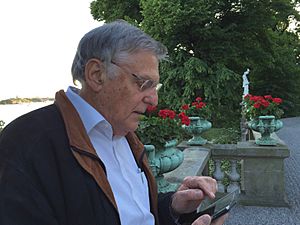Dan Shechtman facts for kids
Quick facts for kids
Dan Shechtman
דן שכטמן |
|
|---|---|

Dan Shechtman, Nobel Prize 2011 press conference.
|
|
| Born | January 24, 1941 Tel Aviv, Mandatory Palestine
|
| Education | Technion – Israel Institute of Technology |
| Alma mater | Technion |
| Known for | Quasicrystals |
| Spouse(s) | Tzipora Shechtman |
| Children | Yoav Shechtman |
| Awards | Weizmann Prize(1993) Israel Prize (1998) Wolf Prize in Physics (1999) Gregori Aminoff Prize (2000) Nobel Prize in Chemistry (2011) |
| Scientific career | |
| Fields | Materials science |
| Institutions | Wright-Patterson Air Force Base Johns Hopkins University National Institute of Standards and Technology Iowa State University Technion Tohoku University |
Dan Shechtman (Hebrew: דן שכטמן; born January 24, 1941) is a famous scientist. He is a professor of materials science at the Technion – Israel Institute of Technology in Israel. He also works with the US Department of Energy and at Iowa State University.
In 1982, while working in Washington, D.C., Shechtman made an amazing discovery. He found a new type of crystal called a quasicrystal. This discovery changed how scientists thought about matter.
He won the 2011 Nobel Prize in Chemistry for finding quasicrystals. He is one of six Israelis to win the Nobel Prize in Chemistry.
Contents
About Dan Shechtman
Dan Shechtman was born in 1941 in Tel Aviv. At that time, it was called Mandatory Palestine. This city became part of the new country of Israel in 1948. He grew up in Petah Tikva and Ramat Gan in a Jewish family. His grandparents had moved to Palestine between 1904 and 1914. They started a printing business.
As a child, Shechtman loved the book The Mysterious Island by Jules Verne. He read it many times. His dream was to become an engineer, like the main character, Cyrus Smith.
I thought that was the best thing a person could do. The engineer in the book knows mechanics and physics, and he creates a whole way of life on the island out of nothing. I wanted to be like that.
Shechtman is married to Professor Tzipora Shechtman. She is a leader in counseling at Haifa University. They have a son, Yoav Shechtman, and three daughters: Tamar Finkelstein, Ella Shechtman-Cory, and Ruth Dougoud-Nevo.
His Journey in Science
Dan Shechtman earned his first degree in mechanical engineering in 1966. He then got his master's degree in materials engineering in 1968. In 1972, he finished his Ph.D. in materials engineering, all from the Technion.
After his Ph.D., he worked as a researcher at Wright Patterson Air Force Base in Ohio for three years. There, he studied how metals like titanium and aluminum are built. In 1975, he joined the materials engineering department at Technion.
From 1981 to 1983, he took a break from Technion to do research at Johns Hopkins University. He studied special aluminum mixtures. During this time, he found the icosahedral phase. This discovery led to the new field of quasiperiodic crystals, or quasicrystals.
Later, from 1992 to 1994, he researched at the National Institute of Standards and Technology (NIST). He studied tiny flaws in man-made diamonds. Shechtman also leads the Wolfson Centre at Technion. He joined the Iowa State faculty in 2004. He spends about five months a year working in Ames. Since 2014, he has been a leader on a science council at Tomsk Polytechnic University in Russia.
What Are Quasicrystals?
When Dan Shechtman first shared his findings about quasicrystals in 1984, many scientists did not believe him. One famous scientist, Linus Pauling, strongly disagreed. Pauling was a two-time Nobel Prize winner.
Shechtman said, "For a long time it was me against the world." He faced a lot of doubt. Pauling even said, "There is no such thing as quasicrystals, only quasi-scientists." Shechtman's own research group leader told him to "go back and read the textbook." He was even asked to leave the team for "bringing disgrace."
But Shechtman knew he was right. Other scientists began to confirm his findings. The Nobel Committee said his discovery was "extremely controversial." However, his work "eventually forced scientists to reconsider their conception of the very nature of matter."
By 1987, other groups were able to create similar quasicrystals. These materials have low heat and electrical conductivity. They are also very stable. Quasicrystals have even been found in nature.
A quasiperiodic crystal, or quasicrystal, is a special kind of structure. It is ordered but does not repeat in a regular pattern. Think of it like a pattern that fills all space but never looks exactly the same twice.
Ancient mosaics in places like the Alhambra palace in Spain and the Darb-i Imam shrine in Iran helped scientists understand quasicrystals. These mosaics follow mathematical rules but never repeat. They often use the "golden ratio" (a special number in math). This ratio is linked to the Fibonacci sequence, where each number is the sum of the two before it.
Quasicrystalline materials could be used for many things. For example, they might make strong steel for tools or non-stick coatings for wires and cooking pans. However, they are not widely used in technology yet.
The Nobel Prize Shechtman received was worth 10 million Swedish krona, which was about 1.5 million US dollars at the time.
Running for President
On January 17, 2014, Dan Shechtman announced he wanted to become the President of Israel. He got enough support from members of the Israeli parliament to run. In the election on June 10, 2014, he received only one vote. Because of this, some people jokingly called him "quasi-president," referring to the "quasi-scientist" comment made about him earlier.
Awards and Honors
- 2019 Honorary John von Neumann Professor title
- 2014 Fray International Sustainability Award, SIPS 2014
- 2013 Honorary doctorate from Bar-Ilan University
- 2011 Nobel Prize in Chemistry for the discovery of quasicrystals
- 2008 European Materials Research Society (E-MRS) 25th Anniversary Award
- 2002 EMET Prize in Chemistry
- 2000 Muriel & David Jacknow Technion Award for Excellence in Teaching
- 2000 Gregori Aminoff Prize of the Royal Swedish Academy of Sciences
- 1999 Wolf Prize in Physics
- 1998 Israel Prize, for Physics
- 1993 Weizmann Science Award
- 1990 Rothschild Prize in Engineering
- 1988 New England Academic Award of the Technion
- 1988 International Award for New Materials of the American Physical Society
- 1986 Physics Award of the Friedenberg Fund for the Advancement of Science and Education
See also
 In Spanish: Dan Shechtman para niños
In Spanish: Dan Shechtman para niños
- List of Israel Prize recipients
- List of Israeli Nobel laureates
- List of Jewish Nobel laureates
- Science and technology in Israel




